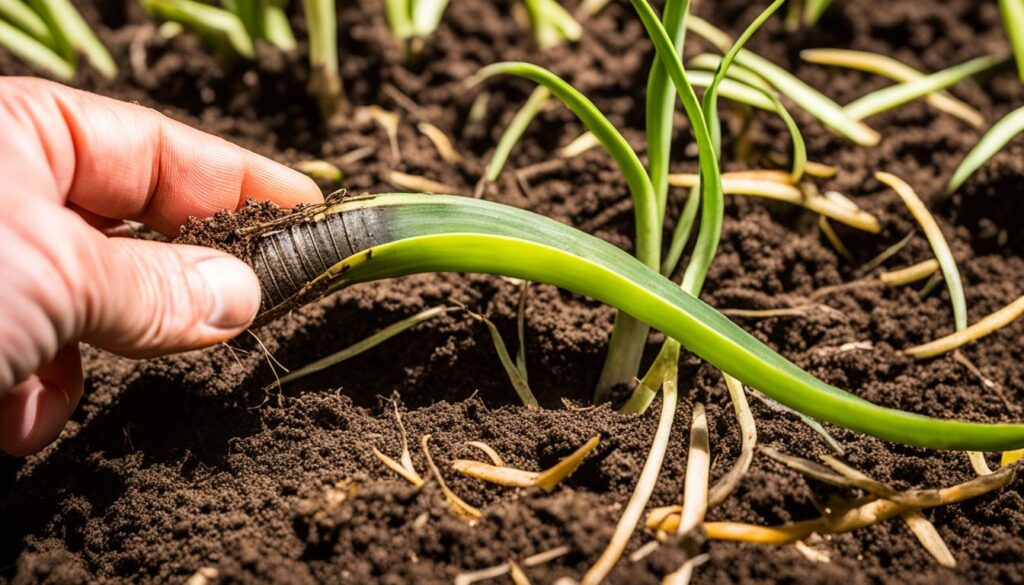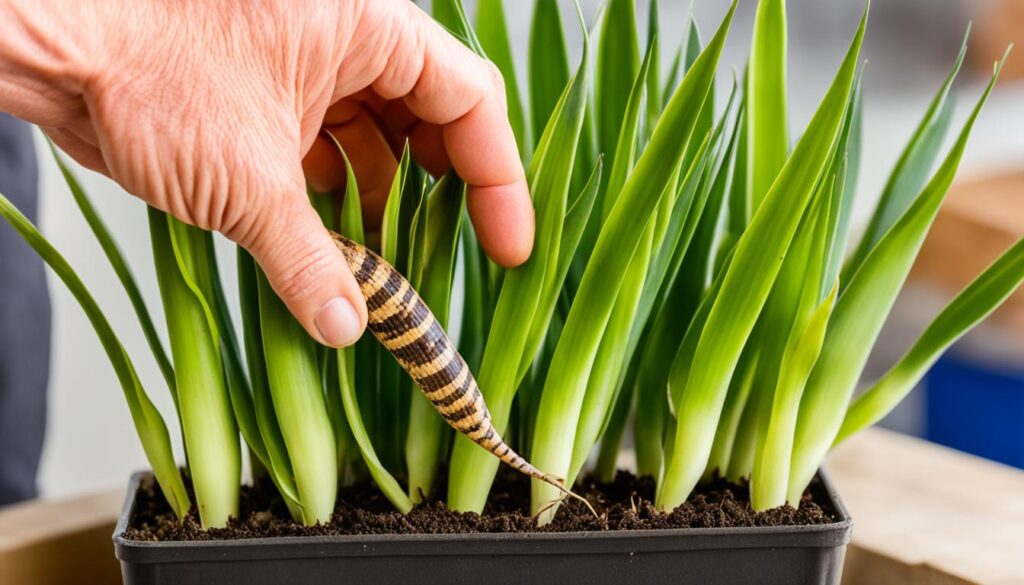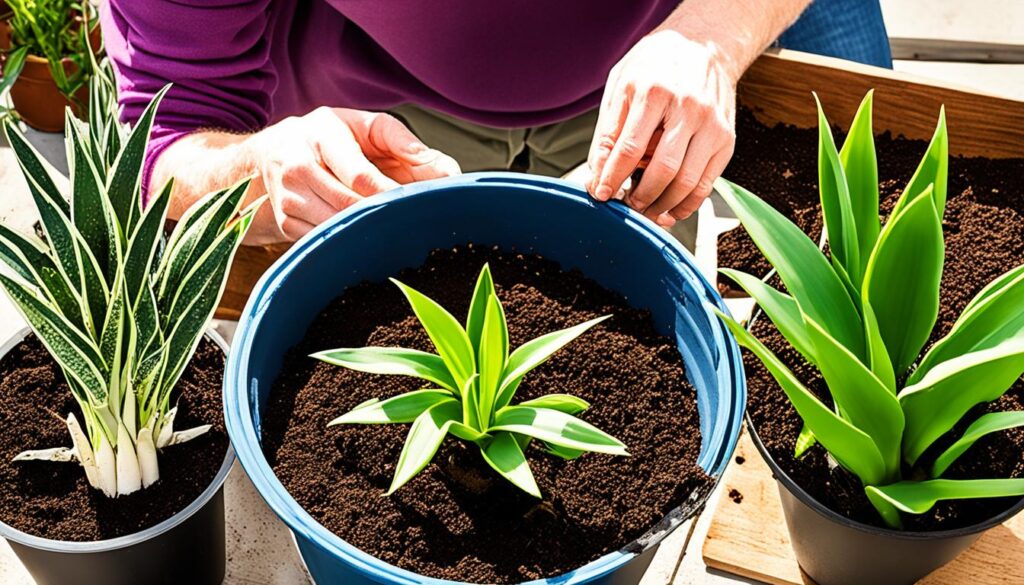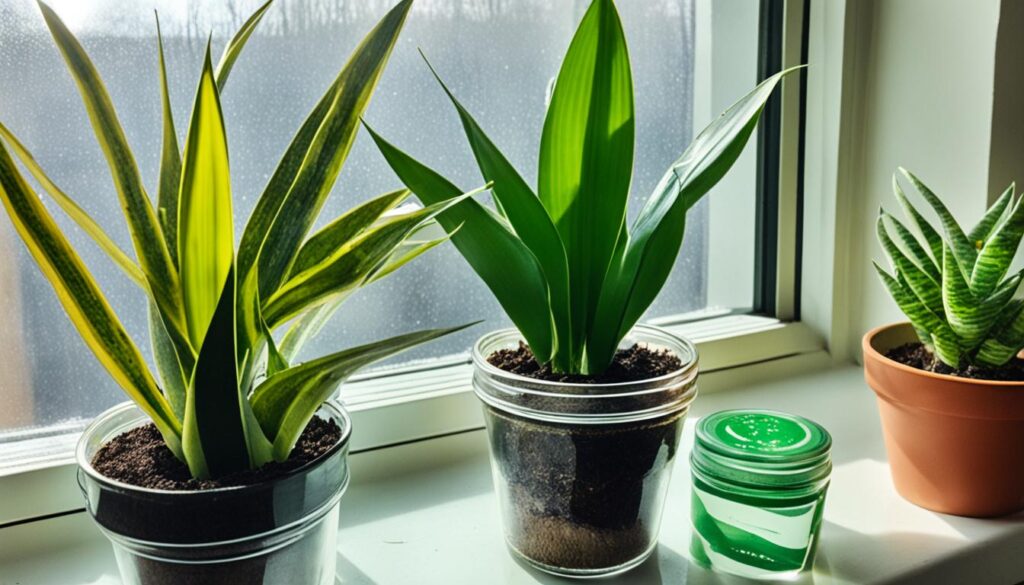A single snake plant can grow up to 8 new plants. This tough succulent is great for indoor gardens because it’s easy to care for and helps clean the air. If you want more plants or to share them with friends, learning how to propagate is a great skill.
Key Takeaways
- Snake plant propagation can be done through four proven methods: water, soil, division, and rhizome.
- Soil propagation allows for faster root growth and the ability to mix different snake plant varieties.
- Water propagation is the easiest method, with visible root growth in 2-4 months.
- Division is a quick way to propagate root-bound plants, while rhizome propagation is a fast method that doesn’t require dividing the original plant.
- Proper care, including adequate lighting, well-draining soil, and controlled watering, is essential for the successful propagation of new snake plants.
What is a Snake Plant?
The snake plant, also known as mother-in-law’s tongue or Dracaena trifasciata, is a popular choice for indoor plants. It has stiff, upright leaves that grow in a rosette pattern. This makes it a visually striking addition to any room. Snake plants are great for beginners because they can thrive in many conditions.
Description of Snake Plant
The snake plant is a succulent with thick, fleshy leaves that can reach up to 3 feet tall. These leaves are usually green but some have yellow or white stripes. The plant’s unique rosette pattern and vertical leaves make it stand out.
Benefits of Growing Snake Plants
Snake plants are great for indoor gardens because they purify the air and are easy to care for. They can remove toxins like formaldehyde and benzene from the air. Their thick leaves also make them tough and able to survive neglect and forgetfulness.
- Air-purifying: Snake plants remove harmful toxins from the air, making them a healthy choice for indoor spaces.
- Drought-tolerant: These plants can go without water for a long time, making them perfect for busy gardeners.
- Adaptable: Snake plants can grow well in a wide range of lighting conditions, from bright sunlight to shaded areas.
- Versatile: Their striking look makes them a great addition to shelves, tabletops, and even offices.
The snake plant is a hardy, easy-to-care-for houseplant that offers many benefits. It’s a great choice for both seasoned plant lovers and beginners. Adding a Sansevieria (snake plant) to your collection is a smart move.
“Snake plants are the ultimate low-maintenance houseplant – they’re practically indestructible!”
How to Propagate a Snake Plant?
Propagating a snake plant, also known as Sansevieria or mother-in-law’s tongue, is a great way to grow new plants. There are several methods to do this, each with its own steps and benefits. Let’s look at the four main ways: water propagation, soil propagation, division, and rhizome propagation.
Water Propagation
To start a snake plant in water, cut a healthy leaf at the base and put it in water. Change the water every week to keep it fresh. In 4-6 weeks, roots should start to grow. When the roots are about 1 inch long, you can move the new plant to a pot with well-draining soil.
Soil Propagation
Soil propagation is easy for snake plants. Take a healthy leaf and cut it into sections with at least one node. Plant these cuttings in a potting mix that drains well. Keep the soil moist but not too wet, and new plants should grow in 2-3 months.
Division
To divide a snake plant, carefully take the plant out of its pot and separate the rhizomes. Make sure each new division has at least three rhizomes and one healthy leaf. Put the divisions in separate pots with a well-draining soil mix.
Rhizome Propagation
For rhizome propagation, take the plant out of its pot and find the rhizomes. Cut the rhizomes into sections, making sure each has at least one growing point. Plant these cuttings in a soil mix that drains well and water them gently. New plants should grow in 2-3 months.
It’s important to make sure the parent plant is healthy and the propagation is done in the active growing season, usually spring or summer. With proper care, you can successfully reproduce your snake plant. This way, you can enjoy its benefits of being low-maintenance and air-purifying for many years.

Water Propagation Method
Propagating a snake plant in water is easy. Begin by cutting a leaf from the plant, near the soil. Put the leaf’s bottom part in a clear glass or container with water, covering 25% of the leaf. Keep it in indirect sunlight and change the water every week.
Over time, new roots will start to grow on the cutting. After a couple of months, when the roots are strong, you can move the cutting to soil. Watch it grow and flourish.
Pros and Cons of Water Propagation
Water propagation is simple and lets you see root growth. But, it has some downsides too. For example, cuttings from variegated plants might lose their unique patterns. Also, it’s the slowest way to propagate Sansevieria plants.
- Simple and straightforward process
- Allows you to observe root growth
- Variegated varieties may lose their unique patterns
- Slowest of the four main propagation methods
Even with its downsides, many love water propagation for its ease and the joy of seeing new life from a leaf cutting.
“Snake plants are considered excellent beginner plants suitable for those with a ‘black thumb.'”
Soil Propagation Method
Propagating a snake plant (Sansevieria trifasciata) in soil is easy and effective. You take leaf cuttings and put them in a well-draining potting mix. This method is loved by many because it’s simple and works well.
Steps for Soil Propagation
- Start by picking a healthy, mature snake plant leaf. Cut it near the soil line with a clean knife or scissors, leaving 2-3 inches attached to the plant.
- Let the cut leaf dry and form a callus for 2-3 days. This step prevents rot and helps roots grow.
- Get a well-draining potting mix, like a succulent or cactus soil blend, in a small pot with holes. Rosy’s snake plant soil mix is a good choice.
- Put the leaf cutting into the soil, burying it 1-2 inches deep. Press the soil gently to make sure the cutting is in contact.
- Water the soil a little, but don’t overdo it. Snake plants can rot easily, so keep the moisture balanced.
- Put the pot in a spot with bright, indirect light, like a sunny windowsill or under a grow light. Don’t put it in direct sunlight, as it can burn the leaves.
- Check the soil often and water only when the top inch feels dry.
- With patience and care, new growth will start from the leaf cutting base. This means the plant is rooting and starting a new life.
The soil method is a reliable way to grow more snake plants. By following these steps, you can easily increase your collection. Enjoy their beauty and easy care in your home or garden.

Plant Propagation by Division
Propagating a snake plant is easy and reliable through division. This method involves taking a mature plant and splitting its root clump into sections. This way, you can make new plants from one parent plant.
Steps for Propagating by Division
- Carefully slide the snake plant out of its pot to reveal the root system.
- Use a sharp, sterile knife or scissors to gently divide the root ball into sections, ensuring each division has at least three rhizomes or a leafy top.
- Prepare individual pots with well-draining potting mix and plant the divided sections, planting them at the same depth as the original plant.
- Water the newly divided plants and place them in a warm, bright location to encourage new root growth.
Pros and Cons of Dividing Snake Plants
Advantages:
- Faster propagation compared to leaf cuttings
- Retains the variegation of the original plant
- Allows for quick multiplication of the plant collection
Disadvantages:
- Requires a mature plant with multiple growth points
- Can be more disruptive to the parent plant
- Divided sections may take longer to establish themselves compared to other propagation methods
By using division to propagate your snake plant, you can grow more plants easily. This method is simple and rewarding, helping you expand your indoor garden.
Rhizome Propagation Method
If you want to grow more snake plants, or sansevieria, using rhizomes is a good choice. Rhizomes are the underground stems. By dividing them, you can easily create new plants.
Steps for Rhizome Propagation
- Carefully slide the parent snake plant out of its pot, exposing the root system.
- Locate the underground rhizomes near the base of the plant.
- Using a clean, sharp knife or pruners, carefully cut off a section of the rhizome, ensuring that it contains at least one growth point or “eye.”
- Allow the rhizome cutting to callus over for 1-2 days, which helps prevent rot.
- Plant the rhizome cutting in a well-draining potting mix, such as a cactus or succulent mix, and water lightly.
Pros and Cons of Rhizome Propagation
Pros:
- Rhizome propagation is a fast and efficient way to generate new snake plants, as the rhizome cuttings will quickly establish themselves and begin growing new foliage.
- This method is particularly well-suited for propagating variegated snake plant varieties, as it allows you to maintain the unique patterns and coloration.
Cons:
- Rhizome propagation requires you to uproot the parent plant, which can be potentially damaging if not done carefully.
- The process of dividing the rhizomes can be delicate and may take some practice to master.
The rhizome propagation method is a great way to quickly grow more snake plants, especially variegated ones. Just remember to handle the parent plant with care and let the rhizome cuttings callus before planting.

Caring for Propagated Snake Plants
Once you’ve grown your snake plants, it’s key to care for them right. This includes knowing their light, water, and soil needs. Let’s look at what your new snake plants need to grow well.
Light Requirements
Give your snake plants bright, indirect sunlight. They can handle low light but grow best in bright spots. Make sure they’re not in direct sunlight to prevent damage.
Watering Needs
Water your snake plants a little at a time. Let the soil dry out before watering again. This prevents root rot. Adjust how often you water based on the plant’s size and the environment.
Soil and Nutrients
Use a potting mix that drains well and has lots of nutrients. A special snake plant soil is perfect for this. It helps with air flow, drainage, and gives the plants what they need to grow.
“Snake plants are incredibly easy to care for and make for an excellent choice for beginner gardeners or those with a busy lifestyle.”
How to propagate a snake plant?
Propagating a snake plant is easy and lets you grow new plants from one you already have. There are several ways to do this, each with its own benefits and things to consider. Let’s look at the steps for propagating a snake plant through different methods.
Water Propagation
Water propagation is a popular method. It means cutting a leaf from the plant and putting it in water. Over time, roots will grow, and you can move the new plant to soil. This method is the slowest but is easy and doesn’t require much work.
Soil Propagation
Soil propagation is another way to grow a new plant. You plant a leaf or stem cutting into a potting mix that drains well. This method works well when mixing different types of Sansevieria, like Sansevieria cylindrica and Sansevieria moonshine, in one pot.
Division
If your snake plant is too big and crowded, division is a good choice. This means taking the plant apart at its roots and rhizomes, giving each part its own leaves and roots. Division is quicker than using just leaves to propagate.
Rhizome Propagation
Rhizome propagation is fast, especially for plants with colorful patterns. You cut the rhizome, the underground stem, into pieces and plant them in soil.
No matter the method, make sure the new snake plants get the right care. This includes good lighting, water, and soil that drains well. With proper care, you can enjoy many beautiful snake plants at home or in your garden.

“Snake plants are considered ideal for individuals with a ‘black thumb’, making them a popular choice for beginners.”
Variegated vs Non-Variegated Snake Plants
Snake plants, also known as Sansevieria or mother-in-law’s tongue, come in solid green and variegated types. Variegated snake plants have leaves with stripes or patterns, making them stand out. But, growing these plants requires a different method than non-variegated ones.
Propagating Variegated Varieties
Water and soil propagation can work for variegated snake plants, but it’s not always successful. These methods might cause new plants to lose their unique patterns. For keeping the variegation, division and rhizome propagation are better choices.
To grow new variegated sansevieria, it’s important to take cuttings or divisions with a piece of the rhizome. This underground stem stores nutrients and helps the plant grow. Keeping the rhizome means the new plants are more likely to keep their variegation.
“Propagating variegated snake plants can be a bit more challenging, but the results are well worth the effort. With the right techniques, you can enjoy the beauty of these patterned plants for years to come.”
Common Problems and Solutions
Propagating snake plants, also known as mother-in-law’s tongue, can be rewarding but has challenges. Common issues include slow root growth, lack of new leaves, and losing the variegation in patterned varieties. These problems can often be fixed by providing the right growing conditions.
One big issue is slow root growth. To fix this, make sure the cuttings or divisions are in a well-draining potting mix and moist. Avoid overwatering, as it can cause root rot. Check the soil moisture and adjust your watering.

Another issue is when new leaves don’t grow. This might be because the plants don’t get enough light or lack nutrients. Move the plants to a bright, indirect spot and give them a balanced fertilizer during the growing season.
Variegated snake plants can lose their color if they don’t get enough light or if the cutting was from a non-variegated part. Make sure the plant gets enough light to keep the variegation.
By solving these common problems, gardeners can enjoy the benefits of these tough and versatile plants.
When to Propagate Snake Plants?
The best time to propagate snake plants, also known as mother-in-law’s tongue or sansevieria, is in the spring or early summer. This is the ideal season for sansevieria propagation. The plant grows actively, and new cuttings or divisions have a good chance of growing roots and developing before the cooler seasons come.
Snake plants are tough and can be propagated all year, but spring and summer are best. During this best time to propagate snake plants, the plant’s growth matches the needs of new cuttings or divisions. This increases the chances of healthy, thriving new plants.
- Propagate snake plants in the spring or early summer for optimal growth
- Avoid propagating during the dormant winter months when the plant focuses on root development
- Soil propagation is recommended in the spring and summer for faster root growth
- Water propagation can take 2-4 months, making it a slower process compared to soil or division methods
- Division is a fast way to propagate root-bound or overgrown snake plants, best done in spring or early summer
Knowing the when to divide mother-in-law’s tongue helps gardeners plan their propagation. This way, they can match their efforts with the plant’s natural growth cycle. This leads to healthier, more vigorous new snake plants.
“The most favorable time for propagating a snake plant is during the spring and early summer months when the plant is in its active growth phase.”
Repotting Propagated Snake Plants
As your snake plants grow, they’ll need bigger pots soon. This step is key for their health, giving them room and nutrients to flourish.
Repot them when the roots fill the pot or when the plant looks root-bound. Slide the plant out of its pot and move it to a new container. Choose one that’s 2-3 inches wider, filled with a cactus or succulent potting mix.
- Carefully remove the snake plant from its current pot, taking care not to damage the delicate roots.
- Choose a new pot that is 2-3 inches wider in diameter than the previous one.
- Fill the bottom of the new pot with a fresh, well-draining potting mix.
- Gently place the snake plant in the center of the new pot and fill in the sides with more potting mix.
- Water the transplanted snake plant thoroughly, and allow the excess water to drain.
Be careful when repotting sansevieria or mother-in-law’s tongue plants. Their roots are sensitive and can get damaged easily. Handle the plant gently to help it adjust to its new home.
“Snake plants are resilient, but they do require some attention when it comes to repotting. Taking the time to do it properly will ensure your propagated plants continue to thrive.”

By following these steps, you can successfully repot your snake plants. This will give them the space and nutrients they need to keep growing strong and healthy.
Conclusion
Snake plants, also known as Sansevieria or mother-in-law’s tongue, are great for both new and seasoned gardeners. They are tough and easy to grow, making them a top choice for indoor spaces. You can easily increase your snake plant collection using four simple methods: water, soil, division, and rhizome propagation.
These methods let you share your plants with friends and family. With the right care, your new snake plants will flourish, adding beauty and greenery to your home. This guide has given you the tools to become a pro at growing Sansevierias.
Looking to grow more plants or share the beauty of snake plants? This guide has everything you need to know. It’s packed with tips and techniques for successful propagation. Start your snake plant journey and watch your collection grow.


